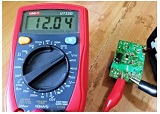Servicing 12 Volt SMPS Adapter

This SMPS 12V Adapter was brought to me with the complaint that it was dead. On opening it, I observed that the tank capacitor was bulgy. Checked the ESR of all electrolytic capacitors and found that except one 47uF/16V in the primary, rest was ok. Checked all the components in the primary as well as the secondary and did not find anything wrong in any of these.

Since the Tank capacitor was 15uF/400V, which is not available in the market, I replaced it with a 22uF/450V.
The size of this is a bit more, but managed to place it in. Replaced the 47uF/16V with a 47uF/25V capacitor.

Removed the secondary wire and soldered two cut pieces of leads in its place to ease checking the output voltages. I take these precautions because such small SMPS adapters might explode like a bomb, and might shock the hell out of you, if not injure you. So, it is better to keep a safe distance. Moreover, to check the DC socket, we need to use both of our hands holding the DC socket and sometimes the inner portion of the DC socket might be too tiny to insert a probe. So, this is my standard practice.
Checked the adapter, by giving the power through a series bulb and otherwise, and found it to be working perfectly fine!

Here you can have a close look at both sides of the PCB:

Thus an adapter was saved from the dump without any complications. Needless to mention that another one added to my satisfaction list.
I have an important news to announce to the readers, which I keep it as a suspense until the next article!

This article was prepared for you by Parasuraman Subramanian from India. He is 69 years old and has more than 30 years’ experience in handling antique equipment like Valve Radio, Amps, Reel Tape Recorders and currently studying latest tech-classes conducted by Kerala State Electronics Technicians’ Association. He has done graduation in BBA degree, private diploma in Radio Engineering and retired as MD of a USA company. Presently working as Consultant to Hospital and other institutions.
Please give a support by clicking on the social buttons below. Your feedback on the post is welcome. Please leave it in the comments.
P.S-If you enjoyed reading this, click here to subscribe to my blog (free subscription). That way, you’ll never miss a post. You can also forward this website link to your friends and colleagues-thanks!
You may check on his previous repair article below:
https://jestineyong.com/servicing-kreft-valve-radio/
 (79)Dislikes
(79)Dislikes (0)
(0)






Mihai
June 18, 2018 at 11:49 am
Hello Mr. Parasuraman !
Thank's for sharing. I'm waiting for the next article.
asif
June 18, 2018 at 1:25 pm
sir
Your articles are very interesting.why dont you teach electronics for all?
Parasuraman
June 18, 2018 at 11:38 pm
That's what Jestine Yong is doing, doesn't he?
James
June 18, 2018 at 2:37 pm
Yup, good stuff'
Robert Calk Jr.
June 18, 2018 at 3:47 pm
Good job, Parasuraman. Can't wait to hear the announcement.
Albert
June 18, 2018 at 9:47 pm
No matter how big or small the device, you are a master in repair! And in keeping us in suspense too!
Henrique Jorge Guimarães Ulbrich
June 18, 2018 at 10:16 pm
Dear Parasuraman, I am impressed with the ease and quickness you solve the problems. Thanks.
R Murali
June 19, 2018 at 2:49 pm
Thanks, sir for sharing , waiting for the next article of yours...
angelo
June 19, 2018 at 9:50 pm
congrats sir
15uf was changed with 22uf, will there be any problem ??
thank you
Parasuraman
June 21, 2018 at 5:50 pm
Nothing, except a slight variation in dc volts. Nothing significant. Manufactures would always try to cut cost by using the components that are just necessary for a safe operation. Only in well designed, precisely balanced circuits, such variation would make difference, as capacitor charge/discharge time, capacity, shape of wave form etc. are critically kept. However, in power supply, such changes do not cause any such major problems. This is what I have learnt!
Humberto
June 20, 2018 at 5:05 am
Thanks for sharing this article. As you said, another device saved from the dump.